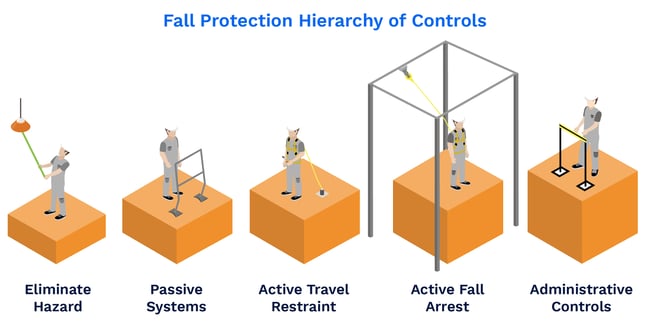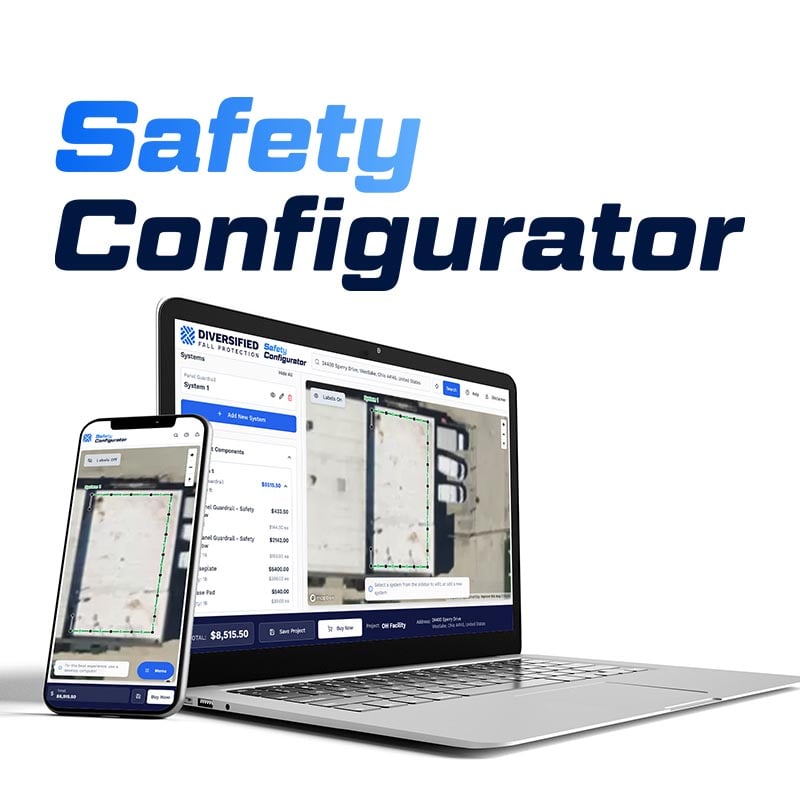
The Difference Between Fall Prevention, Travel Restraint, and Fall Arrest Systems
Fall protection clients often wonder, “What is the difference between fall prevention, travel restraint, and fall arrest systems?” After all, these terms all sound similar enough to be interchangeable.
However, each method of fall protection has a different meaning. This blog article is going to walk you through:
- Fall Prevention vs. Travel Restraint vs. Fall Arrest
- How Does a Fall Prevention System Work?
- What is a Travel Restraint (Fall Restraint) System?
- What is a Fall Arrest System?
- Which Fall Protection is Right For You?
Learn more about each system below, or contact a fall protection specialist to discuss your options.
Fall Prevention vs. Travel Restraint vs. Fall Arrest
In a nutshell, these different fall protection systems each try to protect a worker from fall hazards in a different way.
Fall prevention (passive) systems aim to passively prevent a fall from happening. (ANSI)
Travel restraint systems actively restrain a user from being able to reach an edge or drop-off. (OSHA 1910.21)
Fall arrest systems are designed to stop (or “arrest”) a fall that has already begun. (OSHA 1910.21)
When you understand the difference between these types of fall protection systems, you can choose the best solution for your application.
How Does a Fall Prevention System Work?
Fall prevention systems are passive, meaning they don’t require any change in routine from their users. Someone can simply go about their usual business and be protected from a fall. Many clients prefer a fall prevention approach because it doesn’t require workers to take any preparatory steps prior to entering the work area.
What is an example of a fall prevention system?
One example of a fall prevention system is rooftop guardrail. If you have a perimeter rooftop guardrail system in place, you and your workers are protected from falls the moment you step foot on the roof, all the way until you exit the work area. The guardrail prevents someone from falling over the edge, but it doesn’t require someone to hook into a system, such as with a self-retracting lifeline (SRL).
Fall prevention is the safest approach to rooftop safety. When passive systems are not feasible or when workers need to move freely within the area, it’s helpful to learn your other options.
What is a Travel Restraint (Fall Restraint) System?
A travel restraint system—also referred to as a fall restraint system—is designed to prevent a worker from reaching a fall hazard in the first place. Rather than stopping a fall in progress, it physically restricts movement, ensuring the user cannot get close enough to an unprotected edge or drop to fall at all. However, this system relies on compliant use by the user in order to be effective.
This form of fall protection uses a body harness connected to a fixed-length lanyard and anchorage point. The system is engineered so that even when fully extended, the worker cannot reach the hazard zone.
You may have heard this referred to as "fall restraint" systems. However in the OSHA update to 1910 Subpart D this is clarified and updated to be "travel restraint." This makes more sense as the system isn't restraining a fall, it's restraining travel. But what does a travel restraint system look like?
What does a travel restraint system look like?
Travel restraint is a fall protection strategy that prevents workers from reaching—and tumbling over—an unprotected leading edge. With a travel restraint system, the user is restricted from moving too close to the edge.
These systems can take a variety of forms, including single point anchors and horizontal lifelines. However, each system has a common denominator: Workers must wear a body harness and connect a lanyard to an anchor point.
Fixed single point anchors are used for smaller, clearly defined work areas, while horizontal lifelines are used for larger applications that require maintenance personnel to roam more freely about the rooftop.
What is an example of travel restraint equipment?
A rigid post single-point anchor system is one example of travel restraint equipment. The rigid post anchor is affixed to a beam, allowing a user to attach a lanyard or lifeline to the anchor point on one end and their harness on the other.
Other single point anchor systems, such as portable anchors, vacuum single point anchors, and truss anchor kits, work in a similar fashion, although the method of attachment of the anchor point differs.
What is the purpose of a travel restraint lanyard?
The lanyard used in travel restraint equipment is a key component of the system. The lanyard is engineered to stop the worker from ever reaching the edge, and therefore a fall is prevented. Lanyards for travel restraint are often fixed lengths and must be able to withstand 800 lbs. of force. Note that this requirement is different than what is required for a fall arrest lanyard, described below.
What is a Fall Arrest System?
A fall arrest system is a type of active fall protection designed to halt a fall after it has already begun. It consists of a full-body harness, an anchorage point, a lanyard, and often a deceleration device or lifeline that prevents the worker from striking the surface below.
Fall arrest systems are typically used when it’s not feasible to eliminate or restrict access to a fall hazard—such as during steel erection, tower climbing, or rooftop maintenance. These systems must meet strict performance requirements to absorb the energy of a fall and minimize injury.
In the hierarchy of fall protection, fall arrest systems are a last resort strategy. That’s because they are designed to stop a fall already in progress and the worker will still be exposed to the forces of the fall and suspension trauma.
What is an example of a fall arrest system?
Fall arrest systems often take forms similar to rooftop travel restraint systems, such as single point anchors, horizontal lifelines, or rigid rails.
As with travel restraint systems, workers connect to the system’s anchor points with body harnesses and lanyards. However, for fall arrest applications, the equipment is engineered to withstand the much greater forces associated with stopping falls. Fall arrest systems must stop a fall before an employee strikes surfaces below the work area. As such, a fall arrest lanyard must be able to withstand a dead weight of 5,000 lbs.
Also, fall arrest systems are engineered to account for the forces that accumulate in stopping such a fall using shock absorbers. This prevents the user from sustaining serious bodily harm when the fall is arrested.
Which Fall Protection is Right For You?
The next logical question here is: Which system is best? Most people immediately grasp that preventing a fall from ever happening is preferable to arresting a fall in progress but still need to match the proper system with the application and available budget.
A rooftop guardrail system is nearly foolproof, plus you’ll save on annual inspections and re-certifications. But if your perimeter is very large or you have a severely sloped roof, you’ll need to consider alternatives.
Travel restraint systems are preferable to fall arrest systems, but with some applications, workers have no choice but to work close to the leading edge, making a fall arrest system more appropriate.
Finding the right approach for your rooftop application requires a formula that considers budget, frequency of use, and the precise location of the rooftop work areas. The best way to ensure a safe rooftop work environment is to choose a fall protection company like Diversified Fall Protection. We have the design and installation credentials to meet OSHA fall protection requirements while keeping your personnel safe and productive.
Need help evaluating the right solution? Contact us at Diversified Fall Protection to request a fall safety review
Schedule an assessment with Diversified Fall Protection
Contact Us to request a fall safety review

b-1.jpg?width=1368&height=1340&name=Rail%20(175)b-1.jpg)




%20Close%20Up.png?width=420&height=315&name=Rail%20(13)%20Close%20Up.png)